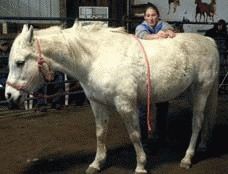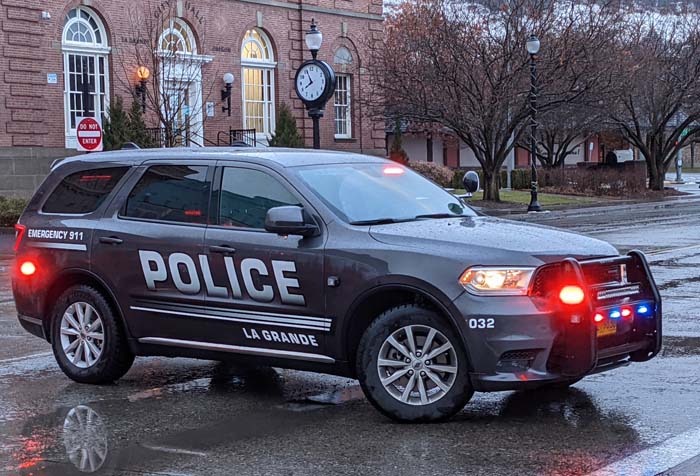BODYWORK FOR HORSES
Published 12:00 am Saturday, February 10, 2007

- FEELS SO GOOD: Emily Bushman loosens the joints in Sarah's spine. The 20-year-old Arabian mare is owned by Richard and Margo Mack of Windwhistle Stable and Arena, La Grande, where Bushman gave a demonstration on equine massage. Bushman, a licensed veterinary technician and horse trainer, was recently certified as an equine massage therapist. (The Observer/MARDI FORD).
– Mardi Ford
Trending
– The Observer
Few things are as soul-stirring as the sight of a horse in fluid, yet powerful, motion. At leisure, the peaceful ballet of a horse lifting and bowing its head to graze is a pleasure to behold.
Yet underneath that magnificent exterior lies a configuration of muscle, ligaments, tendons, connective tissue, arteries and bone as vulnerable to injury, tension and pain as that of a man’s.
Trending
"We think of them as big tough animals, but they’re not as big and tough as they look," says Emily Bushman of Union. "Horses were not put on this earth for us to ride structurally they’re just not designed for it."
Bushman, a licensed veterinary technician and horse trainer, has seen plenty of horses with back and leg problems, neck and shoulder pain and whole body discomfort that neither her skills as a trainer or vet tech could fully address.
"I wanted to be able to do so much more for them, but I didn’t really know what that was," she explains.
At first, she considered going back to school for a degree in chiropractic equine care, but discovered most schools have geared curriculum toward fully licensed veterinarians.
"You don’t have to be a vet to go, but the way it’s structured it makes it hard if you’re not," she says.
While talking with her farrier, she discovered he knew a little about massage therapy for feet. The concept peaked her interest and she began to look into equine massage.
"I looked for a really long time to find a good school. Most were a couple of days or a week, but you can’t learn stuff like this in a week," Bushman says.
Finally, she found out about the state-accredited Prairie Winds Equine Massage Therapy College in Colorado. The intensive program required a serious commitment from Bushman she had to quit her job at the veterinary clinic to attend.
The school lasted two months. Classes were from 8 a.m. to 5 p.m., six days a week. Upon completion, Bushman was certified as an equine massage therapist.
She is the first to admit it sounds unusual.
"Equine massage is not what it sounds like, not what people think. There’s no aromatherapy involved no hot stones or almond-scented oil," she jokes. "What I do is hard to explain, but it involves recharging the muscles and increasing nerve comfort. I work the horse’s whole body, which is why I call my business Bodywork for Horses. But I can’t really explain what I do, I just have to show people," she says.
Although each massage is tailored to what the individual horse needs, Bushman starts with the spine, loosening up the joints and getting them to move. Besides being good for limbering up the back, this also allows the horse to adjust to Bushman. And she has a chance to gauge the horse’s receptiveness.
Next, she moves to the poll, the part of the horse’s neck right behind the ears. Bushman says, just like people, horses hold a lot of tension there and just like people get headaches.
From there, she carefully works the hyoid (the bone that slings the tongue forward and back), moving next to the throat latch, the checks, the neck, shoulders, spine and finally the groin.
Usually by the time she reaches the groin area, the horse understands she is helping. She has never been kicked.
"They’ll warn me if they want to kick. Horses are curious and willing, and they want to please. There’s a reason behind bad behavior. Usually it’s because something hurts," she says.
The layer of fascia that covers the haunch is part of a three-dimensional web that spreads over a horse from head to hoof . It sheaths every muscle, bone, nerve, blood vessel and organ. It’s function is to support, stabilize and cushion. It’s also responsible for movement.
Any tightening of this connective tissue due to injury or restricted movement can cause dysfunction to the entire body. Over time, the quality and quantity of the horse’s athletic ability and performance suffers. It can also be very painful for the horse.
Myofascial release therapy has been used on humans for years, and Bushman uses the same techniques, as well as cranio-sacral and shiatsu massage, in a combination that provides amazing results.
Not long ago, she got a call from a client in Hermiston asking if she would come take a look at an old roping horse turned brood mare.
The mare was cranky, flighty and didn’t like to be touched. Released from lead rope or halter, she immediately got as far away from humans as she could. The odd thing was that her babies were totally mellow.
"Crazy mares generally pass that trait on to their kids, so I knew it probably wasn’t genetics. A lot of the time, a really cranky animal is just in pain," she says.
When the cowboy found out Bushman was a massage therapist, he was not impressed. He though he’d called a chiropractor.
"He told me if he’d known I was a massage therapist, he wouldn’t have called me. But since I was already there, he told me to go ahead and see if I could help her," she says.
Bushman could feel the quivering tension in the mare’s muscles as soon as she put her hands on her. There was mental tension, as well.
During the session, the horse’s owner was amazed to discover his bad-tempered mare standing for Bushman like a docile lamb without being held. By the time she finished, the mare was actually following Bushman around.
"The guy couldn’t believe it. He said she wasn’t even the same horse. But I think she was finally the horse she wanted to be, instead of the horse she was supposed to be," Bushman says.
Another client called her out to look at a gelding suffering from ring bone, a serious and painful arthritic condition affecting a horse’s hoof.
The gelding’s temperament had changed, his owner said. Once her best friend, he preferred being left alone and untouched.
Bushman soon discovered the gelding was holding tension on his left side where the leg was worse. The tension in his neck and shoulder, had caused a big knot and she suspects a doozy of a headache. As she began to work the poll and the muscles in his neck, the big gelding’s head dropped, his ears went flat and his eyes kind of glazed over as if to say, "Oh, yeah, right there, That’s the spot."
Not all horses are as responsive. Some hold back. And injuries are something Bushman can’t permanently fix, though she can give relief.
"But there’s always a change. I just show them where the blood flow has shut down and what muscles have become unresponsive," Bushman says.
The horses respond by moving and stretching out in ways that help the therapy work. And just as each horse is different, so is each massage.
"This is not a one-size-fits-all therapy. Mostly, I go with my gut. A lot of what I learned at school is to feel through me what the horse is trying to tell me. School gave me the keys, but the more horses I work on the more I learn," Bushman says. "Honestly, when I went to school, I had no idea what to expect. I learned more than I ever dreamed. And I knew I wanted to do something with this make a business working with horses."
Being a vet tech, a horse trainer and now an equine massage therapist provides Bushman with a package of skills designed to help horses lead more productive lives. She charges $75 per session for the massage therapy and there is no set time. Some horses can be helped in an hour, some take a little longer. Depending on how disconnected the horse has become from its body, Bushman says, some may need more than one session. Others do fine after one, but may need a follow up. A lot depends on whether what caused the problem in the first place remains unchanged.
Besides massage therapy, Bushman’s Bodywork for Horses also provides horse training, saddle fit clinics and sheath cleaning. For more information, call Bushman at 910-1712.









